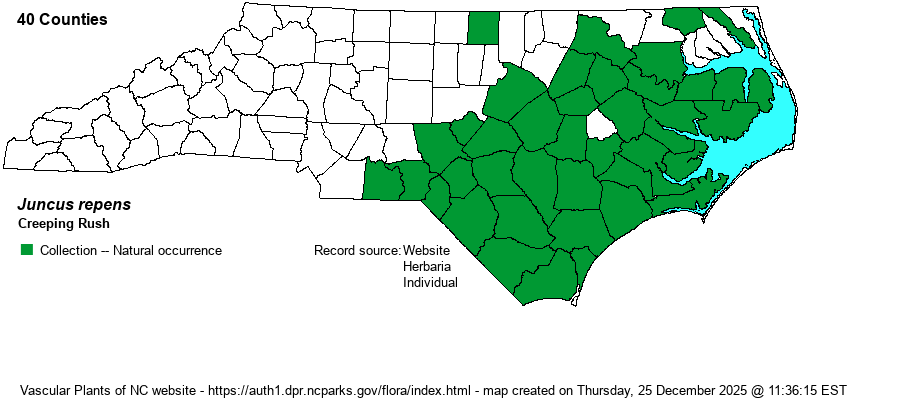| Author | Michaux | |
| Distribution | Coastal Plain and Sandhills; slightly disjunct to Person County in the eastern Piedmont. A specimen from Lake Chatuge in Clay County (Mountains) is misidentified.
Mostly Coastal Plain, DE to FL, eastern TX, southeastern OK, and AR; TN; central Mex.; Cuba. | |
| Abundance | Common and readily found nearly throughout the Coastal Plain and Sandhills, though seemingly less numerous in the northern counties. Very rare in the eastern Piedmont. The State Rank is clearly S5, and not S4 as given by the NCNHP. | |
| Habitat | Shallow water of blackwater rivers (and brownwater?), impoundments, beaver ponds, depression ponds, Carolina bays, inundated ditches and canals; also exposed bottoms and shores of the above. | |
| Phenology | Flowering and fruiting June-October; depends on lowered water level to reproduce. | |
| Identification | Creeping Rush is a soft and "lazy" plant that is easily identified by its "mat-like" appearance. It typically forms dense colonies or patches via horizontal runners, and it roots at the nodes to produce new stems. Stems have a few to several whorls of relatively flat, slender leaves (or simply opposite). As water recedes, stems produce green to yellowish floral heads with the 3 inner tepals much longer than the 3 outer ones. Flowering stems are less than 8 inches tall. | |
| Taxonomic Comments | None
NOTE on Juncus: These "grasslike" or "sedgelike" plants occur in most habitats, especially where moist or wet. They can immediately be told from grasses and sedges by the presence of 6 tepals (petal-like) that surround the fruit. These tepals can be thought of as analogous to sepals and petals of, say, lilies or trilliums. Most species have brown, chestnut, or reddish tepals and dark brown fruits. The flowers occur in few- to many-flowered heads. Leaves are nearly all basal and round in cross-section. Stems are unbranched, except for the inflorescence. Fruits are termed capsules and contain many tiny seeds. | |
| Other Common Name(s) | None | |
| State Rank | S4 [S5] | |
| Global Rank | G5 | |
| State Status | | |
| US Status | | |
| USACE-agcp | OBL link |
| USACE-emp | OBL link |

